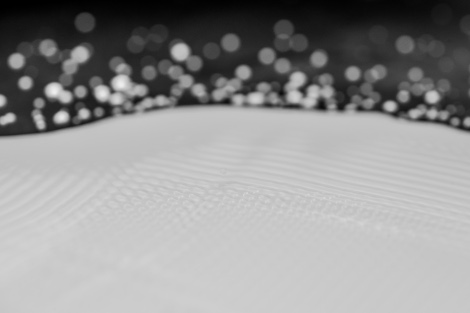
NR 13
Sonic Art, Sonic Practice, and Sonic Thought: Artistic Research and Music Today

Sound and Music: Interwoven Terrains for Artistic Research
Sound is omnipresent, and we live, think, feel, and experience in and through sound every day. Sound studies have developed mainly in the disciplines of acoustics and music. The former defines sound as mechanical waves while the latter considers it as discrete sounds organised in time. Artistic Research offers us opportunities to study sound from a different perspective. How do we live, think, feel, and experience in and through sound as artistic practitioners? What constitutes such knowledge production, and how does this search for knowledge relate to the other modes of knowledge and experience often associated with ‘music'?
RUUKKU 13 explores these questions by collecting case studies and insights related to the making of artistic event/work involving sound. Our hypothesis has been that artistic practitioners invent and grasp knowledge on their way to establishing what will become new art, new practice, and new thought in sound. Our main interest is to find out the extent and diversity of artistic knowledge production in and through sound. The questions are approached in the context of environmental issues, historicity, technology, tradition, and all art or performative forms that involve sound.
One of the themes that run through all the expositions in this issue is the intense feeling and sensitivity towards the overlapping area between sound and music. The pioneering ethnomusicologist, late Bruno Nettl (1930-2020) questioned this conceptual borderline in the opening chapter ‘The Art of Combining Tones' of his seminal book The Study of Ethnomusicology (1983). He pointed out differing criteria for the definition of music (the difference arising from individual cultural contexts), and the subjectivity involved in making these definitions. Today, we observe that the liminal space between sound and music is more volatile, larger, and more complex; that sound studies and music studies become indistinguishable when it is approached from the perspectives of artistic practitioners.
The six expositions in RUUKKU 13 can be seen to form two groups according to their author perspectives, reflecting the varied discourses of artistic research in the neighbouring fields of music and sound art. One group presents musicians Marianna Henriksson, Pauliina Syrjälä and Nathan Riki Thomson, whose practices emphasise the central role of instrumental performance. Starting from an intimate relation with their instrument, their work develops through compositional and curatorial challenges in dialogue between sound, people and diverse materials to the creation of idiosyncratic, moving performance.
The other group comprising Budhaditya Chattopadhyay, Nicola Di Croce and Eleni-Ira Panourgia presents sound artists. They approach this fertile area between sound and music as site-specific composers (where a ‘site' may be conceptual) and set up material in distinct ways in order to create an aural experience. Their emphasis on the experience of the participants engages their creativity in ways that also reveal their political and environmental concerns.
The exposition by Budhaditya Chattopadhyay promotes critical and discursive immersion in sound art, where the listener participates in active engagement with the work. He demonstrates the methods he employs in realising such immersion and provides critical reflection on the practice.
Nicola Di Croce's exposition focuses on the sonic atmosphere of urban locations and the possibilities of artistic agency in designing urban soundscapes. His work seeks to contribute to an empowerment of marginalised municipalities through collaborative governance of immaterial commons. The exposition presents results from a 2018 ‘field-work' as an artist in residency in Guardia Sanframondi, Italy.
In her exposition, harpsichordist Marianna Henriksson explores the performer's experience of playing a Frescobaldi toccata: a musician's transcendental and procedural act of turning the written music into sounding music. Central to Henriksson's approach is the concept of desire that she illuminates with excerpts from 16th- and 17th-century sources and present-day research related to Frescobaldi and toccatas.
Eleni-Ira Panourgia's exposition offers an insight into an entanglement of sculptural and sonic practices, where sculptural work on physical materials fuses with sonic exploration. Panourgia analyses her research-practice through the notion of ‘co-composition', pointing to an artistic practice where the formal, structural and temporal dimensions are intrinsically merged.
In her exposition, kantele player Pauliina Syrjälä discusses the practice of composing music for herself as a performing musician and Finnish folk music professional. Her relationship to her instrument, a particular historical kantele model, is in focus as she studies and renews its sound, playing styles, and repertoire. Syrjälä opens up her method of using improvisation in composing by reflecting on the creation of one of her works.
Double bass player Nathan Riki Thomson discusses in his exposition the collaborative process of music-making in an intercultural setting as a possibility of expanding one's approaches and practices and in the formation of individual artistic identity. Thomson presents two musical duets as case studies to illustrate the emergence of a third space, a catalyst for new musical discoveries. A central concept is resonance in music and sound as well as in human communication: a crucial aspect in creating the environment conducive to meaningful musical interaction.
The RUUKKU issue Sonic Art, Sonic Practice, Sonic Thought develops ideas from the symposium Encounters, Discussions, Experimentations: Art, Research, and Artistic Research in Music at the Venice Research Pavilion, hosted by the University of the Arts Helsinki on 16-17 June 2017 at Sala del Camino, Venice. The world has moved on a long way since then, and our thoughts and sensibilities have moved on too. We hope that this issue provides a snapshot of varied perspectives on, and relationship to ‘being creative in and through sound' in the present world.
The issue's cover photo is from Nathan Riki Thomson's exposition (Culebro, Thomson, 2018).
Enjoy exploring the world of sound and music through these insightful expositions!
Ruukku 13 issue editors; Mieko Kanno, Otso Lähdeoja, Kristiina Ilmonen, Päivi Järviö, Markus Kuikka

